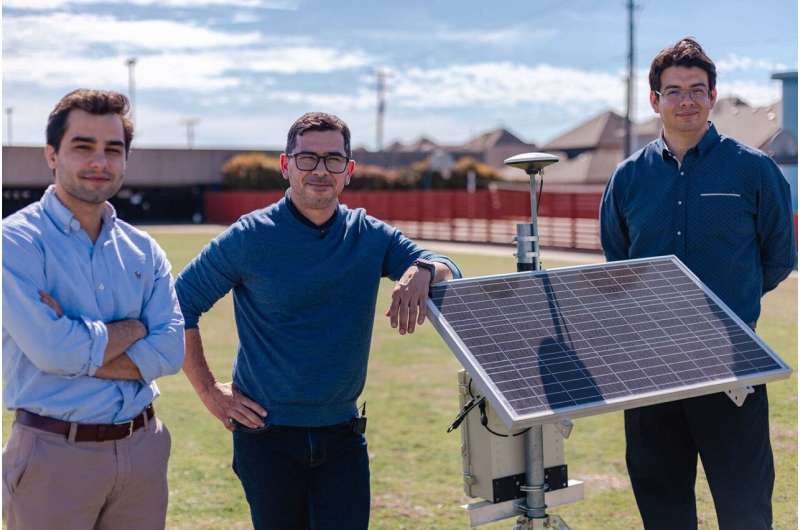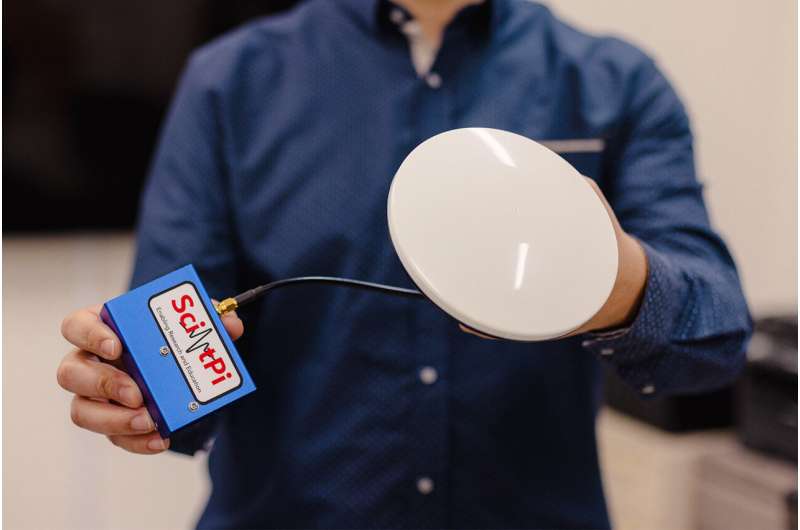This article has been reviewed according to Science X's editorial process and policies. Editors have highlighted the following attributes while ensuring the content's credibility:
fact-checked
trusted source
proofread
Space scientists' new sensors shine spotlight on sun-Earth studies

Small, low-cost sensors developed by space scientists at The University of Texas at Dallas to study the Earth's upper atmosphere recently—and unexpectedly—provided information about the sun, something the devices were not designed to do.
The devices, called ionospheric scintillation monitors, or ScintPi sensors, will be in the spotlight again as UT Dallas researchers deploy them to collect data during the April 8 total solar eclipse and make them available for citizen science projects.
"The ScintPi sensors receive radio signals from satellites, similar to the GPS receivers in cellphones," said Dr. Fabiano Rodrigues, associate professor of physics and Fellow, Eugene McDermott Distinguished Professor in the School of Natural Sciences and Mathematics at UT Dallas.
"They can be easily deployed and maintained and cost about $600 for us to build, which is much less than commercial versions that cost between $10,000 and $15,000."
While ScintPi sensors are not intended to fully replace commercial monitors, they can be used in many educational and scientific applications, Rodrigues said.
Radio signals exchanged between the ground-based devices and satellites travel through a region of the Earth's atmosphere called the ionosphere. Solar radiation creates the ionosphere by stripping electrons from atmospheric atoms, which results in a shell of charged particles, or ions, around the Earth.
Disturbances and turbulence in the ionosphere can affect radio communications and the quality of GPS radio signals. A better understanding of the dynamics of the region and the factors affecting it helps scientists develop models to forecast variability more accurately.
"On the daylight side of the Earth, when there is the most solar radiation, there is more ionosphere—a greater density of electrons. At night, the density of electrons decreases, and there is less ionosphere," said Rodrigues, who uses a variety of ground-based equipment to study the ionosphere.
As part of his graduate studies, Josemaría Gómez Sócola, an electrical engineering doctoral student in the Erik Jonsson School of Engineering and Computer Science, developed the ScintPi sensors so that scientists and citizen scientists around the world could gather data on ion density. The time it takes radio signals to travel to and from satellites is used to determine ion density in the region above a sensor's location. The research was published in the Journal of Space Weather and Space Climate.
The sensors have been deployed at 23 sites across the Western Hemisphere, including in Brazil, Honduras, Peru, Puerto Rico, Costa Rica, 12 U.S. states and Iceland, so that scientists can study the ionosphere at low, medium and high latitudes.
Solar science
Isaac Wright BS, a physics doctoral student, analyzed data from the sensors gathered in 2022 and noticed something unusual about Aug. 28, 2022. The data showed a brief degradation of radio signals, but the cause was not a disturbance in the ionosphere.

The researchers determined that the signal was affected by noise resulting from a short increase in the level of radio signals of a certain frequency emanating from the sun. The solar radio burst (SRB) lasted about 30 minutes.
"This was not what we were looking for," Wright said. "Our sensors are designed to study the ionosphere, not solar events; nevertheless, we detected a solar radio burst, which shows that low-cost sensors like ours could be used for studies beyond just the ionosphere. We've shown that we can quantify how much solar radio bursts and ionospheric disturbances affect signals like GPS."
Only a few solar radio bursts have been reported at the frequency band used by GPS.
"This event was interesting because it was detected at the frequency used by our network of GPS receivers," Rodrigues said. "And it might have been missed—one of the main ground-based radio telescopes that detects and reports SRBs was not operational on this day."
Solar eclipse experiment
"Our experimental setup for the April 8 total solar eclipse has two goals: to increase literacy about the Earth's ionosphere and to create new datasets that quantify the effects of eclipses on the ionosphere," said Rodrigues, who directs the Upper Atmosphere Remote Sensing Lab in the William B. Hanson Center for Space Sciences.
Sensors along the path of the eclipse will gather data from sites that will experience a partial eclipse in New Hampshire, Pennsylvania and Illinois, as well as at UT Dallas, which is in the path of totality.
Data from the UTD sensor is displayed on a website that captures and plots the concentration of electrons in the ionosphere over 48 hours. Rodrigues plans to project the near-real-time layout of electrons onto a large screen on campus to show viewers the changes in the ionosphere during the total solar eclipse.
During the annular solar eclipse of Oct. 14, 2023, which occurred around midday over much of Texas, ScintPi sensors measured the dip in the electron concentration in the ionosphere as radiation from the sun was partially blocked by the moon and photo-ionization decreased. After the eclipse, it went back up again as solar radiation returned to normal.
"During the total solar eclipse, we expect there to be an even bigger dip in the ionospheric concentration near Dallas because we are in the path of totality, and the Earth will receive much less radiation from the sun," Rodrigues said.
"We have models of the ionosphere, but we want to know how well these models match up with our observations. The research we're doing at UT Dallas and the measurements we make can help to verify and refine those models."
More information: Isaac G. Wright et al, On the detection of a solar radio burst event that occurred on 28 August 2022 and its effect on GNSS signals as observed by ionospheric scintillation monitors distributed over the American sector, Journal of Space Weather and Space Climate (2023). DOI: 10.1051/swsc/2023027
Provided by University of Texas at Dallas





















